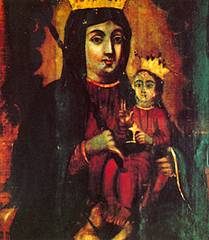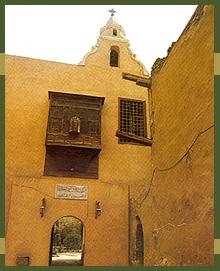|
THE
HOLY FAMILY AT MATAREYA, AIN SHAMS & ZEITOUN
 An icon at Virgin Mary Church - Zeitoun
An icon at Virgin Mary Church - Zeitoun |
Eventually,
They left the desert behind them and made their way southwards,
crossing the Nile to its eastern bank, and heading for Matariyah
and Ain Shams (ancient Heliopolis, the site of the oldest
'university' in history called 'On' since earliest Pharaonic
times). Both these adjacent districts are outlying suburbs
of present day Cairo, only about 10 kms from the city centre.
At the time of the Holy Family's arrival, Ain Shams was home
to a large Jewish community, which had erected the Synagogue
of Unias for their worship. In Matariyah, a tree still stands
to this day, called 'Mary's Tree", for the Family is believed
to have rested in its shade. Here, too, the Infant Jesus caused
water to flow from a spring, from which He drank and blessed,
and in which the Virgin washed His clothes. She poured the
washing water on to the ground, and from that spot, the fragrant
balsam plant blossomed. Besides the healing and pain-soothing
properties of this balm, its essence is used in the preparation
of the scents and perfumes of which the holy Chrism is composed.
On
their way to Old Cairo, the Holy Family rested for a while
in Zeitoun. The Holy Family then proceeded along a course
which traverses what are now crowded, bustling quarters of
Cairo, within which the serene landmarks of an earlier Coptic
heritage still stand, marking the paths the Holy Family followed.
THE
HOLY FAMILY WITHIN THE AREA OF OLD CAIRO
Central
Cairo
- The
Church of the Virgin Mary in Zuweila Alley.
- The
Church of St George the Martyr.
-
The Church of St Mercurios Abu Sefein (he of the Two Swords).
- The
Convent of the Virgin Mary.
- The
Convent of St George.
Down-town
district of Clot Bey
- The
Cathedral of St Mark in Azbekieh.
|

|
- Numerous
churches attached to the Cairo headquarters of many of Egypt's
monasteries.
- The
Church of the Virgin Mary (known as Ezbaweya).
The
area now called Old Cairo, known as Misr El Kadima, is among
the most important locations visited by the Holy Family where
the spiritual impact of their presence is still felt. Their
stay here was brief, for the Governor of what was then Fustat
- enraged by the tumbling down of idols at Jesus's approach
- sought to kill the Child.
They
took shelter from his wrath in a cave above which, in later
years, the Church of Abu Serga (St Sergius) was built. This,
and the whole area of the Fort of Babylon, is a destination
of pilgrimage not only for the Egyptians but for Christians
from around the world.
The
following is a list of the sites visitors to the Fortress
of Babylon section of Old Cairo visit:
- The
Church of Abu Serga and the Crypt of the Holy Family beneath
it.
- Al-
Muallaqa (Hanging Church) dedicated to the Virgin Mary,
Patriarchal See of the Coptic Church in the early centuries.
- The
Church of St Barbara.
- The
Chuch of St George (in the Palace of Waxworks).
- The
Church of the Virgin, identified by its alternative name
of Qasriet Al-Rihan.
- The
Convent of St George.
- The
Coptic Museum and the ramparts of the Fortress of Babylon.
- The
Greek Orthodox Church of St George.
- The
Jewish Synagogue of Ben Ezra.

Virgin Mary Church (Qasriet Al Rihan) |
The
Fustat section of Old Cairo, which lies west of the Mosque
of Amr Ibn'l Aas, includes:
- The
Church of St Mercurios Abu Sefein (he of the two Swords).
- The
Church of Abba Shenouda.
- The
Church of the Virgin Mary of Al-Demshiria.
- The
Convent of Abu Sefein.
- The
Church of the Virgin of Babylon El Darag.
- The
Church of Saints Abakir and Yohanna.
- The
Church of Prince Tadros Al Mishriqi.
- The
Church of the Archangel Mikhail (known also as Al-Malak
Al-Qibili - or 'Southern Angel')
- The
Church of St Mena in Zahraa - Misr El Kadima.
|
|